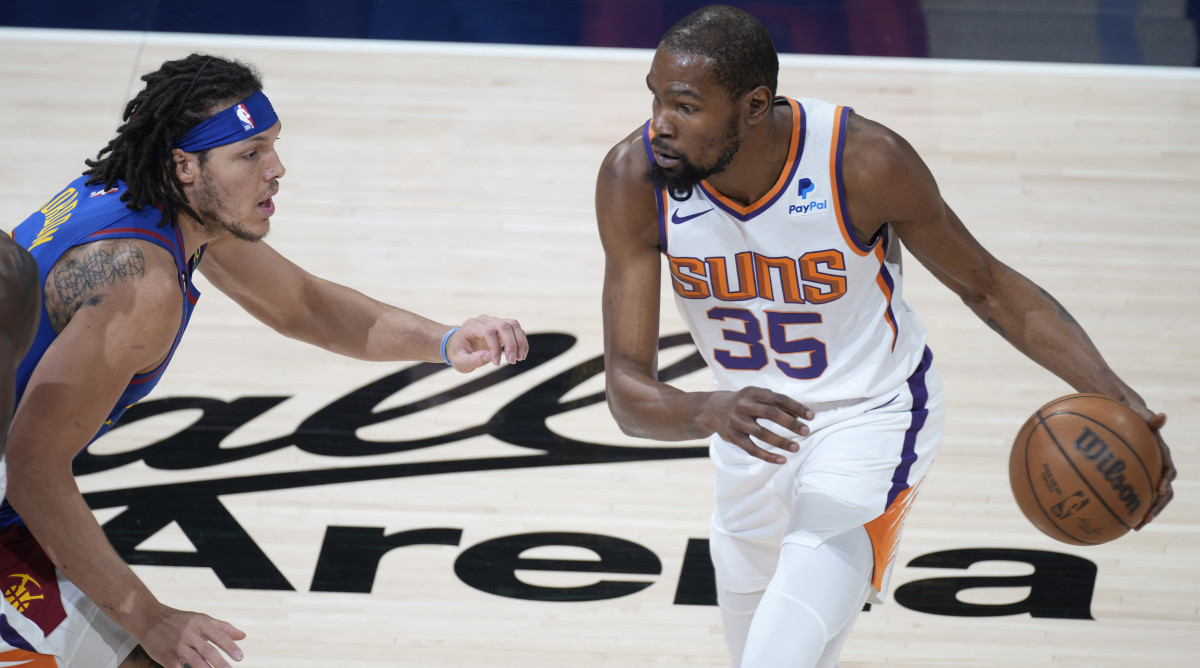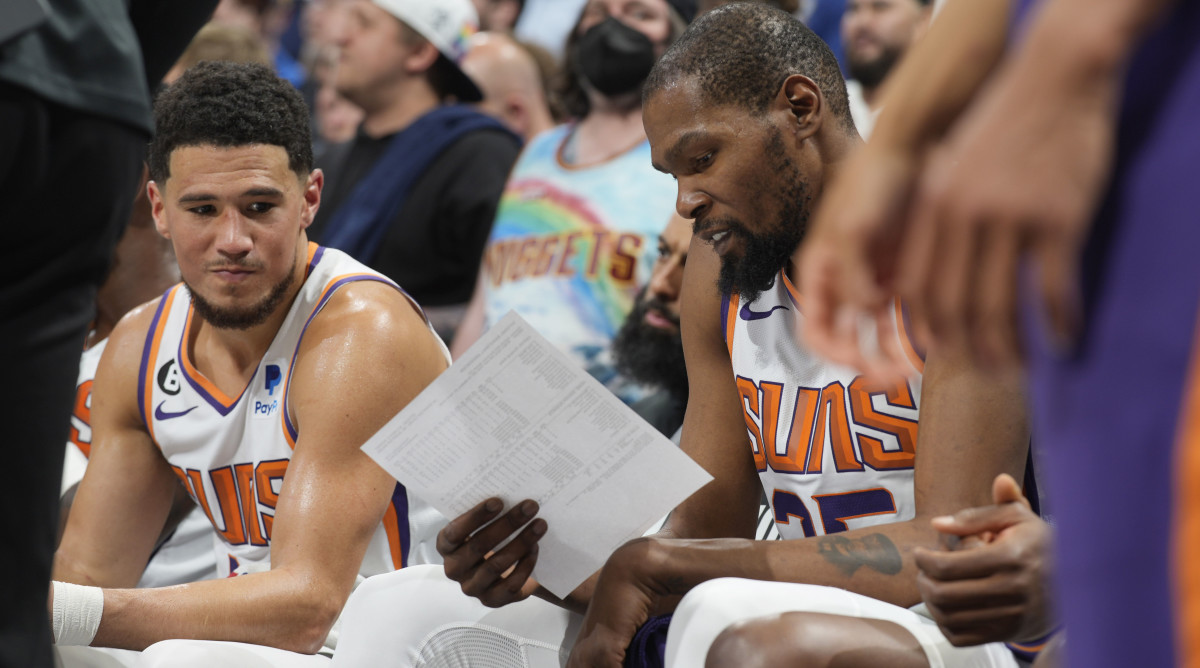The Suns’ Playoff Offense Is Playing in the Past

The Suns entered Game 1 of their series with the Nuggets with the best offensive efficiency of any team in the first round of the playoffs. They left Game 1 with a resounding 125–107 loss and their worst offensive performance of the postseason so far. Denver, not exactly known for its defensive prowess, was able to limit the output of a team featuring three generational offensive talents. The Suns helped their opponent’s cause, though, because for some reason, a team stacked with great shooters isn’t shooting any threes.
Okay, Phoenix is shooting some threes. But not enough! Through seven playoff games, the Suns are averaging an early 2000s-esque 23.5 threes a night. That would be the fewest threes launched per game during the postseason for a team since ’19. The team with the second-fewest attempts is the Knicks, and they are taking seven more a game. Meanwhile, Kevin Durant is shooting 4.5 threes a night. Of all players who have played at least two postseason games, Durant is ranked 56th in three-point attempts. Devin Booker hasn’t been letting it fly much more often, coming in at 5.2 attempts from deep per game, or 45th among the playoff field. Just for fun, here is a partial list of players shooting (or who shot more) more threes than Durant and Booker a game: John Collins, Royce O’Neale, Russell Westbrook, Derrick White, Gabe Vincent, Marcus Smart and Austin Reaves.
In the first round, this strategy made sense for the Suns. The Clippers played a fairly conservative drop coverage for the majority of the series, inviting a lot of pull-up, midrange twos. That is the bread and butter for Durant, Booker and Chris Paul. All three of them have made a very comfortable living on that exact shot, and they eliminated the Clippers by hitting an astronomical rate of their midrange jumpers.

Denver ain’t Los Angeles, though. The Nuggets, to account for their personnel (largely Nikola Jokić), are much more likely to send two to the ball in screen and rolls. Jokić isn’t a stalwart drop defender like a Brook Lopez or Joel Embiid. He’s best utilized showing out on the ballhandler when his defender sets a pick, forcing Denver’s help defenders and screen navigators to scramble aggressively and fight quickly over picks.
In theory, Phoenix should be able to exploit this. The Suns often have a great shooter one or two passes away from the ball. If the pick-and-roll initiator is seeing two defenders, he can make a quick pass to Deandre Ayton in the middle of the floor, Phoenix collapses the defense and Ayton kicks out to a shooter. Or the ballhandler is able to turn the corner and put the Nuggets into a rotation. We saw the Warriors do this quite a bit last year, when they shot 36 threes a game against a Denver team constantly running in circles defensively.
The Suns have not grown accustomed to that style of basketball yet, however. Durant, Paul and Booker still look like a trio figuring out how to best play together. Phoenix’s pure shotmaking ability was able to make relatively quick work of a wounded Clippers team. That seemingly won’t cut it this round. The Nuggets aren’t the 1996 Bulls on defense, but they are well connected and have built up habits over the course of a full season.
In Game 1, Phoenix’s attention to detail left a lot to be desired. Ayton especially set too many soft screens or didn’t roll with enough of a purpose. In the pick-and-roll, so much starts with Ayton. The more contact he puts on the ballhandler’s defender, the longer it takes for them to recover to their man, and the tension increases for Denver’s defense. Meanwhile, players off the ball need to be ready to catch and shoot. Booker will sometimes roam a little bit too far off the three-point line. Paul sometimes doesn’t look like he wants to launch from deep.

CP3 especially will be interesting to keep an eye on as the series matures. The frequency of his catch-and-shoot looks has increased significantly in the playoffs as he spends more time off the ball with Durant on the floor. Paul has a great shooting touch, but he’s connecting on only 31.3% of his catch-and-shoot threes in the postseason. Sometimes when he has a clean look, he seems more comfortable putting the ball on the floor than firing freely. If Paul isn’t a willing shooter, Denver will continue to help aggressively off him on the perimeter, further muddying the Suns’ midrange looks.
Three-point shooting was ultimately only one issue for Phoenix in Game 1. Also not helping matters was Denver’s dominance on the offensive glass as well as the Suns’ 16 turnovers. Still, Phoenix shot a robust 51.2%, and its 110.5 offensive rating in Game 1 was practically the equivalent of the regular-season Rockets (Houston had the third-worst offensive efficiency in the league this year at 110.3.). For comparison, Denver took 37 threes in Game 1 and was plus-27 from deep. Its offensive rating was 127.6.
The Suns will have a few different paths to victory in this series. Seemingly, one of the more fun ones would be to start launching from deep.
